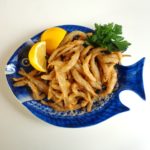 This quintessential French dish evokes happy days at the seaside, where plates of small crispy fish are served up along with a chilled bottle of white or rosé. For me, petite friture inevitably makes me think of summer, which is perhaps why — after this long, dark, cold Parisian winter — I decided to try making it at home when I came across an inviting mound of tiny, silvery fish at a market the other day. Preparation proved surprisingly simple.
This quintessential French dish evokes happy days at the seaside, where plates of small crispy fish are served up along with a chilled bottle of white or rosé. For me, petite friture inevitably makes me think of summer, which is perhaps why — after this long, dark, cold Parisian winter — I decided to try making it at home when I came across an inviting mound of tiny, silvery fish at a market the other day. Preparation proved surprisingly simple.
Petite friture / Fish fry, French style
As the name implies, the fish used in petite friture are very small, even tiny. The fish are rinsed, dried, coated with flour and deep fried in batches. You can keep them warm in the oven until ready to serve — and you eat them whole. They can be served with drinks at cocktail hour, or (more commonly) as a starter or a main course. They need only be accompanied by a little lemon, or if you prefer you can make a French-style sauce tartare, in which capers, tarragon and chopped pickles are added to mayonnaise.
The only problem may be finding the tiny fish. I have looked in vain for them many times at the farmers market in my neighborhood. The fishmonger says they are seasonal, but the season differs for different types of fish. Such a search may be even more difficult in other countries. But the effort of hunting is worth it.
The next question is which fish to use. The most common variety in France is the éperlan, which translates into English as smelt. Well — I know a thing or two about smelt. As a child growing up in Wisconsin, every year in the spring, when the close-to-shore ice over Lake Michigan had melted and the smelt run started, my brother and I were roused from bed in the middle of the night and driven to the shore, our father at the wheel, to join up with other families to go smelting. This involved wading into the freezing waters with large nets that would be dipped and raised full of wriggling small fish. Which my mother then had to figure out how to cook.
We did not do a lot of deep frying in my family — my mom pan-fried the smelt — and in fact I rarely attempted it until my daughter, then a young teen, decided one day that she absolutely had to have doughnuts, right then, right there. So she found a French recipe for beignets and headed into the kitchen. I was distracted, watching a movie on TV or some such, and couldn’t believe it when she reappeared with a plate of piping hot, sugary doughnuts. She went on to perfect the art of making frites — French fries — from scratch. (I may have to ask her to write a guest column on that.)
Since then, I, too, have waded into deep frying, with considerable success. By the way, friture, which translates literally as ‘frying’, is used in many expressions in France. For example, un bain de friture, literally ‘a frying bath’, means oil for deep frying. Petite friture, literally ‘small fry’, always refers to fish. Other fried foods are identified by their names — for example, friture de courgettes (deep-fried zucchini), calamars frits (deep-fried squid), etc. And of course pommes frites (French-fried potatoes).
This method of cooking is populaire over here — meaning not only that it is popular, but also that it is appreciated by people who live modestly, perhaps because it is typically used for dishes that are as inexpensive as they are tasty. Petite friture falls into that category — I bought a pound of éperlans for only 2.50 euros. And I couldn’t keep my daughter away from the stove as the fish came out of their frying bath, hot, crispy and delicious.
Happy cooking.





Wonderful story. In Spain there is a fish that is similar to smelts or “petite friture”it’s called “chanquetes”and cooked similarly, whole and deep fried, delicious. It is difficult to find now because some years ago, it was decided by the authorities that they were juvenile fish, probably fresh anchovies before maturity. Occasionally it is found in some restaurants in Andalucía.
Maribel, thanks for this interesting tidbit!